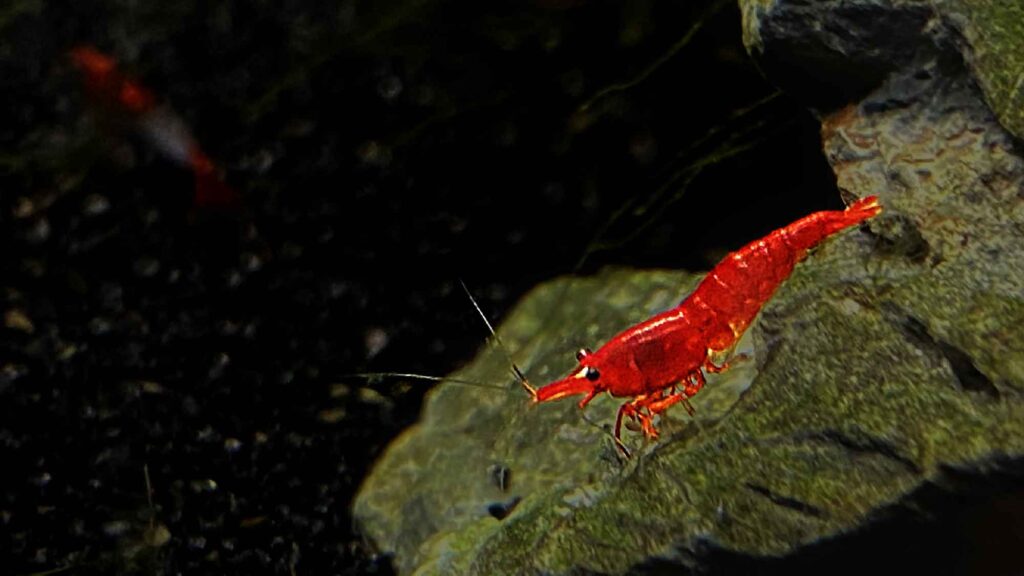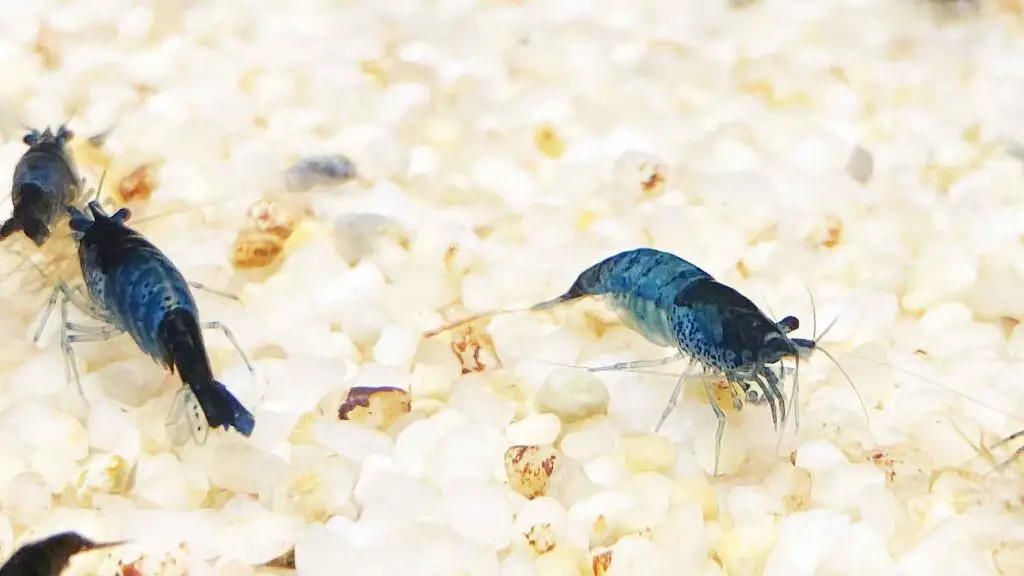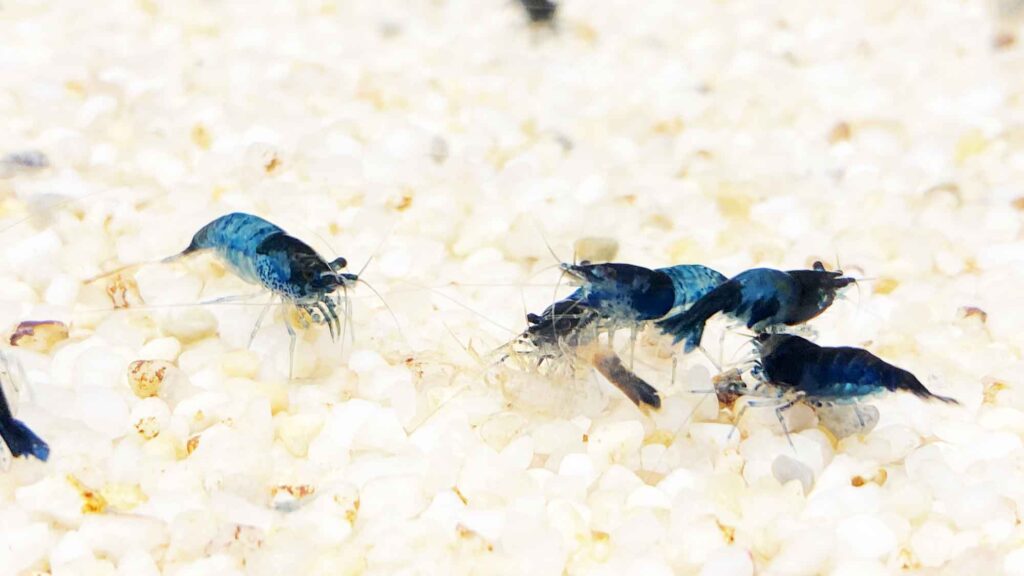Neocaridina are a type of dwarf shrimps that are widely available in the aquarium trade. This shrimp is line bred to multiple colors and available in most pet stores under different names like Cherry Shrimp, Blue Dream, and many more types.
In this article, we will discuss everything you need to know about Neocaridina.
Neocaridina Overview
Since Neocaridina Shrimps are super easy to keep and breed, they are widely available in pet stores across North America. Though you might not see the word “Neocaridina ” written on the pet stores labels, that’s because these shrimps are line bred to multiple colors and each color morph is given a different trade name. You’ve probably seen or kept Cherry shrimps as they are widely available, Cherry shrimp is a color morph of the wild type.
Neocaridina is originally from eastern China and was later introduced in Taiwan, Japan, Hawaii, and slowly to the rest of the world as an aquarium pet. In the wild, they are usually found in small streams and ponds that have a very slow water current.
These shrimps are one of the smallest and most vibrant invertebrates available for freshwater aquariums. The wild type of this species is green-brown-ish and not as desirable as line-bred options. After many years of line breeding, we now have red, blue, black, green, violet, yellow, orange, and many other morphs of Neocaridina.
Appearance

This small size shrimp have five pairs of legs called Pereopods that are used for walking and handling food when eating. The first two pairs of legs have tiny claws that are used to grasp and process food.
Other than the 5 pairs of legs Neocaridina also has 5 pairs of Pleopods. Pleopods are small arms found beneath the belly between legs and the tail of the shrimp. Females use these limbs to hold their eggs until they hatch.
They also have whiskers or antennae around their mouth that are used to scan, touch, smell or taste things by sampling the chemicals in the water.
Lifespan
Neocaridina shrimp live a short life, about 1-2 years. If you keep them in optimal water parameters with a balanced diet they will easily reach two years old. These shrimps develop and mature quickly and in just a couple of weeks, they hatch and grow into adults. During the growth process, shrimps continuously molt their skin and after each molt, they become bigger.
Neocaridina shrimp may not have a long life, but they grow rapidly and breed almost every month when they are adults. This makes it easy to keep a healthy colony of them without worrying about losing your shrimps after a year or two.
Adult Size
Neocaridina shrimp is one of the smallest aquarium shrimps and will grow to about 1-2 inches in length. Fry are tiny versions of their parents and are only one millimeter in length right after hatching. However, in just about 75 days these fries will grow to adult size and start reproducing.
Female Neocaridina Shrimps tend to grow bigger in size compared to the males, This is because females will have to carry the eggs under their belly for about 30 days until the eggs hatch.
Behavior and Temperament
Neocaridina Shrimps are not aggressive and will not cause any harm to other aquarium creatures of any size. They will nonstop graze on the biofilms that form on plants, driftwood, and other objects in the tank. They will also eat any uneaten food or dead fish or shrimp. This makes them one of the best aquarium cleaners for your tank.
Neocaridina also feeds on small microorganisms such as nematodes, rotifers, tardigrades, ciliates, and other microorganisms that might live in an aquarium. This plays an important role in keeping a balanced and healthy aquarium.
Overall, these shrimps will reduce the amount of biomass in your aquarium and as a result, the water parameters will not fluctuate quickly in the aquarium.
Neocaridina Care
Neo Shrimps are one of the easiest shrimps to care for in your aquarium. Shrimps are one of the most low-maintenance aquarium pets in the hobby and can live in a wide range of water parameters. Neocaridina are hardy and adaptable shrimps but they don’t do well when water parameters are not stable.
Maintaining constant water parameters in the tank is crucial to keep your shrimps healthy and breed them more often. Neo shrimps do well in a tank with tropical conditions. The ideal temperature for them is 72 – 78 Degrees Fahrenheit. When the water is on the colder side they will live longer but will breed less and with temperatures on the higher side they will reproduce faster but the life expectancy of the shrimps will drop.
The pH of the water has to stay constant at around 7.0-7.5 for optimal growth and reproduction. Neo shrimps seem to enjoy shades in nature, thus, we recommend using a low intense lighting system for your shrimp tanks.
Water current is another important thing to keep an eye on. Neocaridina Shrimps do not like fast-moving water, when setting up your tank try to lower the flow as much as possible.
Copper is the number one enemy of shrimps, when choosing decorations, substrate, and foods make sure to check they do not have any copper in them as copper will poison shrimps to death.
Tank Size
Shrimps are cleaning creatures and unlike fish, they will not produce huge amounts of waste. This means you can keep a larger number of shrimps in a smaller size tank. When Selecting a tank for your shrimps, always think about the number of shrimps you are planning to keep.
Small colonies of shrimps can live in a 10-gallon tank while larger tanks will let you have a bigger colony. If you have the space, always go for the biggest aquarium you can afford. with bigger aquariums, it’s easier to maintain constant parameters in the tank and shrimps love that.
Tank Setup:
When setting up an aquarium for neo shrimps it’s important to create as much surface area as possible as these shrimps will feed on the algae film grown on surfaces. The best way to create more surface area is to add live aquarium plants. These plants will also help with keeping pattern parameters constant and clean.
Java Moss and Subwassertang are the ideal aquatic plants for shrimp tanks. They are very easy to grow and do not need high lighting and will provide shrimps with lots of surface area and hiding spots.
Adding driftwood is another option to create more surface area. The algae film grown on the surface of driftwood is a sought-after delicacy for shrimps. Cholla wood is the best driftwood for shrimp tanks as it provides lots of surface area while adding all the benefits of regular driftwoods.
Lighting:
In nature, these shrimps live in small streams and ponds that are usually in shades of trees in the jungle. Having low intensity lighting will mimic that condition in your aquarium. The good news is that our recommended plants for shrimp tanks also need low intense lighting. Both Java moss and Subwassertang will live happily with your shrimps and will remove toxins from water.
Filter System:
The ideal filter for shrimps is a simple sponge filter. All other types of filtrations are too strong for shrimp tanks both in terms of the water current they create and the risk of sucking shrimp fry in.
Shrimps produce a very minimum amount of waste which means you very rarely need to clean your sponge filters. The only downside with Sponge filters is the fact that they produce noise.
If noise is an issue for you, then a hang-on back filter is another option you can use. simply add a sponge at intake of the filter so it does not suck the fry in.
Common Diseases and Prevention
Neocaridina shrimps are susceptible to all common aquarium diseases. You should handle your tanks carefully and do not add any fish or plants without quarantining them properly.
Avoid adding anything to your aquarium that has copper in it. This includes decorations, medications, and food. Copper will kill shrimps.

Diet and Feeding Requirements
Neocaridina shrimps will eat almost anything. In a well-planted aquarium, they get food naturally by eating algae and algae film off aquarium plants. However, you will still need to feed them a small amount daily. You can feed your shrimp the regular fish food you feed your fish or buy special food made for shrimp.
When selecting a food for your shrimps be sure to check that the food does not contain copper as copper can eradicate an entire colony of shrimps in a matter of hours.
Calcium for Neocaridina Shrimps
Shrimps constantly molt and the crust they molt is made of calcium. That means they need a constant source of calcium so they can molt and grow properly. Younger shrimps will grow rapidly and calcium is required for them to grow healthy shells.
Altho calcium can be found in most pet foods, the amount is very low so you will need to supplement calcium from time to time. There are multiple calcium supplement products for aquariums available online and in pet stores. But the easiest and cheapest way to add calcium to your aquarium is crushed egg shells. Egg shells are a great source of calcium.
Gender Differences
Male Neocaridina are generally smaller and less colorful than female Neocaridina. The male’s tail is thinner since it isn’t used to transport eggs. Although the female is normally bigger and is richer in color, selective breeding might result in males with comparable coloration.
In more translucent individuals, the growing eggs on the ovaries can be seen on the upper region of the female’s torso, on the “shoulder.” The color of their eggs will depend upon the breed of shrimp. The form of the shrimp’s ovaries drapes across both sides, attaining the moniker “saddle.” The existence of a “saddle” signals that the female is ready to mate.
Breeding
During the breeding time, you might see males swimming super fast in the tank and that’s because females release pheromones into the water telling males she is ready for breeding. Males will keep searching for the female until they find and mate with her.
Most neo shrimps attain sexual maturity roughly at 3-4 months old. Once they reach maturity the females will start to develop eggs that later will fertilize the male. Once eggs are fertile the female will keep the eggs under her belly for about 25-35 days until they hatch.
During this time the water parameters have to be constant to avoid any stress to the female, otherwise, the female might drop the eggs and you will lose all that fry. Since the eggs are carried under the female’s belly, you can monitor the development of eggs and if you are lucky you might even observe them hatching.
With the right food, females might be ready to mate again right after their eggs are hatched.
Tank Mates
Neocaridina are very small shrimps and they don’t have any natural defense mechanism which makes them very vulnerable. Almost all fish will hunt and eat shrimp especially when they are at the fry stages. We do not recommend keeping fish with your shrimps if you are looking to breed a large colony of your shrimps. A species- only tank is ideal for Neocaridina shrimps.
That being said there are also a few fish and invertebrates that seem to not eat shrimp fry. Most freshwater snails are safe for shrimps; this includes: Malaysian Trumpet Snail, Ramshorn Snail, Nerite Snail, and Bladder Snail are among the snails that do not harm your shrimps. However, they might compete over food with the shrimps.
We have also kept shrimps with Otocinclus species and Bristlenose Plecos and they seem to not show any interest in shrimp and shrimp fry. You can also keep them with Caridina Shrimps.

Conclusion
The Neocaridina shrimps are small vibrant pet shrimps that are easy to care for. With the information available in this article, we hope you breed a strong colony of shrimps. If you have any questions you can always reach out to us via email.